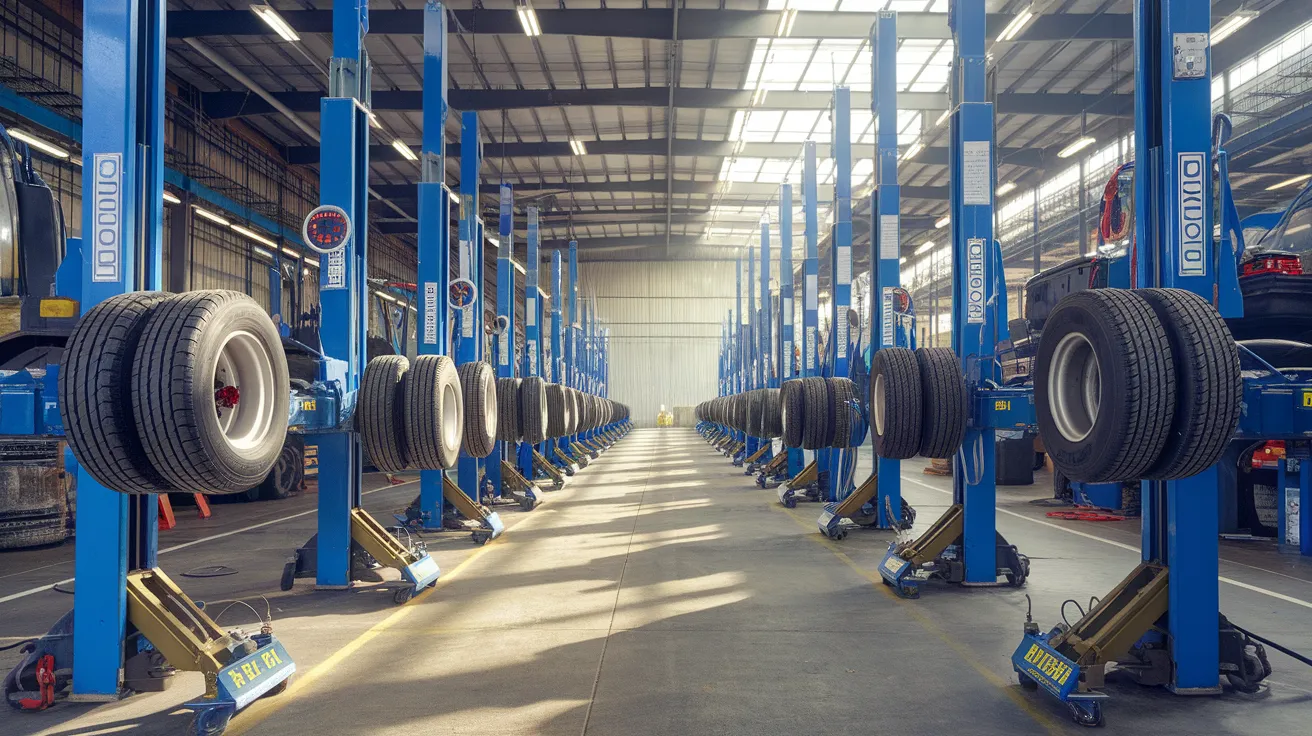Keeping your trucks running smoothly isn't complicated. The key lies in regular maintenance checks, identifying problems before they worsen, monitoring fleet status, and adopting prevention-focused strategies. Routine inspections and repairs guarantee optimal uptime, enhanced performance, and protection. Professional advice from experts like Jim will guide you through fleet maintenance through the smart implementation of digital tools, thorough documentation, and well-trained personnel. Go ahead, immerse yourself in the ultimate guide to fleet maintenance and unlock efficient operations. There's so much to discover and master!

Main Insights
Recognizing the Critical Role of Routine Commercial Vehicle Maintenance
Though it could feel overwhelming, getting a handle on regular truck and fleet maintenance is crucial for any thriving operation. You'll find the advantages of maintenance far outweigh your investment of time and energy. Routine inspections and maintenance can significantly extend your vehicles' longevity, preventing expensive replacements. Moreover, there's an obvious relationship between regularly maintained fleet and better fuel economy. This results in reduced gas expenses, improving your total operational efficiency. Furthermore, regular upkeep can detect small problems before they become serious problems, saving you expensive repair costs later on. Thus, don't underestimate the value of regular upkeep; it can be a significant factor for your operation's success.
Examining Critical Aspects of a Successful Maintenance Framework
To guarantee your fleet's longevity and efficiency, it's crucial to recognize the key components of a well-designed maintenance program. You'll must comprehend the basic principles of maintenance, assess the status of your fleet consistently, and put in place preventive measures proactively. With these in place, you're well on your way to decreasing downtime and optimizing productivity.
Critical System Maintenance Features
If you're looking to boost your fleet's productivity and longevity, implementing a robust maintenance program is crucial. Key components of the program include regular inspections, systematic servicing, and preventive repairs. Every component is essential in minimizing major malfunctions and limiting downtime. While the advantages of a maintenance program are substantial, don't ignore the implementation challenges. These often involve logistical issues and team reluctance. However, with proper planning, clear communication, and focus on skill development, these obstacles can be overcome. Remember that an well-designed maintenance program goes beyond fixing problems; it averts them. It's an investment in your fleet's longevity – and it's one that will yield significant returns.
Vehicle Condition Tracking
When examining the key elements of a effective maintenance program, acknowledging the critical role of fleet condition monitoring becomes paramount. It's not just about ensuring vehicle functionality, it centers on optimizing fleet performance. Vehicle tracking solutions offer a thorough view of your fleet's status, empowering you to detect potential issues before they become serious.
These advanced systems monitor key metrics like fuel efficiency, tire health, engine status, and more. Through analyzing this data, you're not only ensuring the durability of your fleet but also reducing unplanned repair expenses. Note that proactive identification is essential in fleet management. Thus, invest in reliable monitoring solutions and stay ahead of the curve. Don't just react to problems, anticipate them. Maintain your fleet's optimal condition and your enterprise will operate efficiently.
Setting Up Preventive Strategies
Although tracking your fleet's condition is crucial, implementing preventive measures is equally important get more info to maintain a effective maintenance program. It's important to detect potential problems before they escalate into costly repairs or downtime. So, let's talk preventive measures.
One effective measure is establishing a comprehensive maintenance checklist. This list should specify all necessary checks, service tasks, and component updates. Routine engine inspections, tire maintenance, and oil changes are a given. Make sure to include basic components like wipers, lighting systems, and filters.
Make sure your checklist contains a timeline for all maintenance tasks. Adhering to this schedule makes certain that your fleet maintains optimal performance. Don't forget, preventive measures cuts down on time, money, and headaches in the long run.
Key Maintenance Tasks for Commercial Vehicle Management
To make certain your vehicles continue to be in optimal condition, you should prioritize regular maintenance examinations. These checks include scheduled maintenance inspections and key parts inspection. By maintaining these essential routines, you'll maximize your fleet's longevity, improve operational performance, and in the end, minimize major repair expenses.
Periodic Maintenance Reviews
Regular maintenance inspections serve as your strongest line of defense against unexpected vehicle and fleet malfunctions. These inspections offer you an opportunity to identify and resolve issues before they develop into serious accidents or expensive repairs. A key advantages of regular maintenance is the prevention of downtime, which can greatly impact your company's productivity and bottom line.
Critical Component Checks
Expanding upon the critical nature of scheduled maintenance inspections, let's move towards the specific essential component checks that ought to be carried out regularly to guarantee maximum truck and fleet performance. Begin by checking the brake system – confirm all components are working properly, from brake pads to fluid levels, and checking for leaks. If ignored, brakes may malfunction, leading to devastating incidents. Tire pressure checks are equally important. Insufficient pressure elevates fuel consumption and tire wear, while excessive pressure can cause a blowout. Obtain a reliable pressure gauge for accurate readings. Note that tires should be cold during checks for best results. Routinely carrying out these important checks can prevent costly repairs and potential accidents. Drive safely on the road.
Strategic Maintenance Planning for Fleet Optimization
In fleet management, it's vital that you focus on preventative maintenance to ensure peak efficiency. Implementing a well-structured preventative scheduling system is crucial. This reduces unnecessary wear and tear, and decreases the likelihood of unscheduled downtime. You should schedule regular checks and servicing based on mileage, time, engine hours, or fuel used. Note that each vehicle is different and could require a personalized approach.
Maintenance training is an essential method to secure peak efficiency. Provide your staff with the necessary skills to spot potential issues before they escalate. This reduces downtime but also minimizes expenses. The fusion of scheduled prevention and maintenance education will result in a highly effective and trustworthy fleet. Remember, an ounce of prevention is worth a pound of cure.
Key Advice for Truck and Fleet Service and Rehabilitation
Although truck and fleet repair and restoration can seem overwhelming, understanding the process can make it much simpler. The first thing you should do needs to be to learn about multiple restoration approaches. This knowledge will allow you to spot concerns swiftly and accurately. Following this, organize maintenance work based on the extent of repairs needed and the vehicle's role in your operation. Routinely examine each vehicle for developing concerns and fix them immediately to avoid additional problems. Keep in mind, restoration isn't just about fixing issues, it's aimed at upgrading the vehicle's functionality and longevity. Finally, consistently choose high-quality parts for repairs; they'll last longer and perform better. Follow these principles, and you'll navigate fleet maintenance and renovation effectively.
Harnessing Technological Advances for Cutting-Edge Fleet Management
To maintain a competitive edge in the trucking industry, it's essential to utilize industry innovations for enhanced fleet maintenance. New technologies are rapidly changing the maintenance landscape. Embrace data analytics to analyze your fleet's efficiency and identify maintenance needs before they occur.
Advanced real-time tracking systems can track and monitor engine health and efficiency, fuel usage, and operator performance. Make use of this crucial data to implement preventive maintenance, minimizing costly operational interruptions.
Always prioritize software updates. They usually contain essential updates and fixes that boost your automotive fleet's operational efficiency and security. Be aware that fleet management extends past mechanical care. You're operating in a tech-focused era, and keeping up with industry innovations will promote your vehicles' longevity and profitability. By implementing appropriate procedures, you'll reduce expenses and effort, and safeguard human life.
Questions & Answers
What Credentials Do You Need for an Expert Fleet Service Technician?
You'll need a proper certification, fulfilling the criteria of a recognized mechanic institution. Additionally, you require a thorough skill assessment, proving your knowledge in different areas of fleet maintenance and repair. Experience counts too!
What's the Right Time to Replace Fleet Vehicle Tires?
Just like the seasonal changes, you should regularly check your fleet's tire tread regularly. Yet, experts suggest to swap out tires every three to six years, according to road conditions and usage patterns.
How to Recognize Engine Trouble in Your Truck?
You'll notice engine trouble in trucks via indicators including unusual engine noise or decreased fuel efficiency. Additional indicators are excessive smoke, oil leaks, or possibly an illuminated check engine light that persists.
Does Technology Play a Role in Improving Truck and Fleet Maintenance?
Technology plays a vital role in improving truck maintenance. Modern sensors supply real-time data, while predictive analytics help prevent issues before they arise. You'll notice reduced downtime, enhanced security and as a result, financial benefits. It's revolutionary.
What Maintenance Considerations Apply to Different Types of Fleet Vehicles?
Various vehicles need distinct maintenance schedules. One must account for the intended use, carrying capacity, and driving conditions, as these factors significantly affect the necessary maintenance. Always adjust maintenance specific to the vehicle category.
Closing Remarks
In the end, the focus is on keeping your fleet running smoothly, right? Regular maintenance isn't just a suggestion, it's absolutely necessary. By identifying key components, performing regular inspections, using preventative strategies, and leveraging technological advances, you're going beyond simple upkeep, you're honing a well-oiled machine. And don't forget, truck and fleet repair isn't a failure, it's an opportunity for restoration. Stick with it, and you'll see your fleet's performance, dependability, and durability reach new heights.
 Jennifer Love Hewitt Then & Now!
Jennifer Love Hewitt Then & Now! Jeremy Miller Then & Now!
Jeremy Miller Then & Now! Karyn Parsons Then & Now!
Karyn Parsons Then & Now! Teri Hatcher Then & Now!
Teri Hatcher Then & Now! Sarah Michelle Gellar Then & Now!
Sarah Michelle Gellar Then & Now!